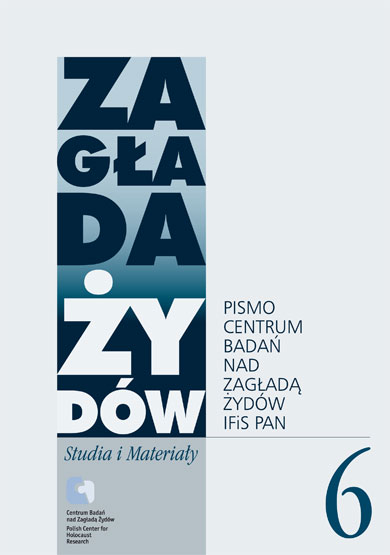Lagry w perspektywie genderowej
Zagłada Żydów. Studia i Materiały, Nr 6 (2010), Strony: 193-204
Data zgłoszenia: 2020-12-06Data publikacji: 2010-12-30
 https://doi.org/10.32927/zzsim.716
https://doi.org/10.32927/zzsim.716
Abstrakt
The questions of corporality, sexuality, women’s experience and their record examined in the context of camp issues and the Holocaust have only recently become the subject of attention. Gender studies play a significant role in the discussion on those issues. Existing works on the subject (i.a. the book of Bożena Karwowska Ciało. Seksualność. Obozy zagłady [Gender, Sexuality, Concentration Camps]) show that the tools of gender studies are cognitively useful, but, as it appears, their role of being particularly predestined to uncover what is marginalized or condemned to silence is overestimated. Nevertheless, apart from the dominance of the patriarchal discourse, there have always existed other reasons for suppressing the matter of corporality and sexuality both in works on KL’s and in science; social taboo (controlled not only by the male symbolical order) as well as the policy (e.g. it was possible to
write openly about rape on former female prisoners by Soviet soldiers only after censorship had been lifted) play an important role here. The fundamental value of the gender perspective lies in the firm approach towards the issues hitherto marginalized in the KL context – both by science and, to a lesser extent, literature (which is reflected by i.a. works of Pankowski and Posmysz published years ago).
Licencja
Prawa autorskie (c) 2010 Autor & "Zagłada Żydów. Studia i Materiały"

Utwór dostępny jest na licencji Creative Commons Uznanie autorstwa 4.0 Międzynarodowe.
https://creativecommons.org/licenses/by/4.0
Podobne artykuły
- Adam Sitarek, Danuta Dąbrowska – pionierka badań nad łódzkim gettem , Zagłada Żydów. Studia i Materiały: Nr 16 (2020)
- Dariusz Libionka, Lokalne struktury Narodowych Sił Zbrojnych wobec ukrywających się Żydów w świetle powojennych materiałów śledczych i procesowych – przypadek powiatów miechowskiego i pińczowskiego , Zagłada Żydów. Studia i Materiały: Nr 16 (2020)
- Barbara Engelking, Jan Górnicki (Ber Oszer Weisbaum), Notatki , Zagłada Żydów. Studia i Materiały: Nr 8 (2012)
- Agnieszka Pajączkowska, Obraz odzyskany. Fotograficzne portrety ocalonych , Zagłada Żydów. Studia i Materiały: Nr 4 (2008)
- Renata Piątkowska, Muzeum Żydowskie i Centrum Tolerancji w Moskwie , Zagłada Żydów. Studia i Materiały: Nr 9 (2013)
- Jerzy Kochanowski, Cisi bohaterowie („Stille Helden”) , Zagłada Żydów. Studia i Materiały: Nr 9 (2013)
- Jacek Leociak, “History and Memory after the Holocaust in Germany, Poland, Russia, and Britain” , Zagłada Żydów. Studia i Materiały: Nr 3 (2007)
- Igor Szczupak, Anna Abakunowa, Omówienia najnowszej literatury na temat Zagłady Żydów: Ukraina , Zagłada Żydów. Studia i Materiały: Nr 3 (2007)
- Tadeusz Bartoś, Niezmienne prawo wielkiej śmierci. Otto Kulka, Pejzaże metropolii śmierci. Komentarz , Zagłada Żydów. Studia i Materiały: Nr 10 (2014)
- Sławomir Buryła, Najnowsze studia na ludobójstwem. Wybrane zagadnienia , Zagłada Żydów. Studia i Materiały: Nr 10 (2014)
<< < 1 2 3 4 5 6 7 8 9 10 11 12 13 14 15 16 17 18 19 20 21 22 23 > >>
Możesz również Rozpocznij zaawansowane wyszukiwanie podobieństw dla tego artykułu.
 English
English
 Język Polski
Język Polski








